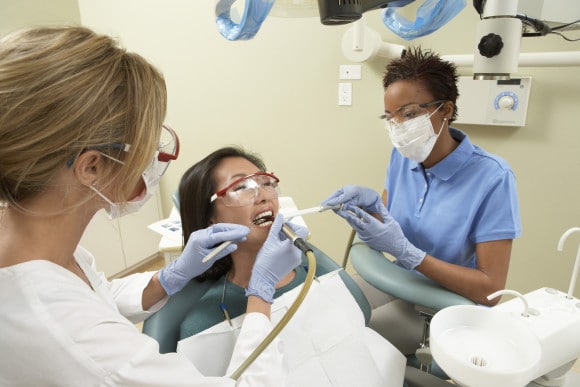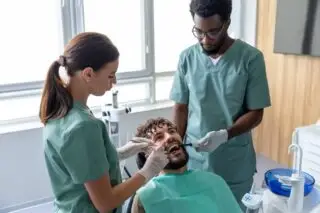 Dental assistants deserve our appreciation and gratitude. These hardworking professionals have a huge influence on today’s dental practices. Drawing on high-level training and an abundance of passion, they do their part to enhance patient comfort and to enhance focus among dentists or dental hygienists.
Dental assistants deserve our appreciation and gratitude. These hardworking professionals have a huge influence on today’s dental practices. Drawing on high-level training and an abundance of passion, they do their part to enhance patient comfort and to enhance focus among dentists or dental hygienists.
As Tosha Gurley tells the Dental Assisting National Board (DANB), the value of the dental assistant extends far beyond chairside help. Every dental team member relies on dental assistants in some capacity. “It’s not just the doctor; it’s not just the front office. It’s hygiene, it’s the patients, it’s the sales reps.”[1]
Given the sheer diversity of these tasks, it’s easy to see the value of comprehensive training. An in-depth understanding of anatomy can fuel effective chairside assistance, but this is only the beginning. Training must also cover radiology, restorative procedures, and preventative techniques, and not simply on a theoretical basis.
True immersion means getting intimately familiar with the realities of dental assisting. This means familiarizing yourself with the day-to-day tasks that shape everything from patient comfort to sanitization, as well as the general flow of the dental practice. These insights can be gained through hands-on dental assistant training.
What Is Hands-on Training for Dental Assisting?
In higher education, the term ‘hands-on’ describes a distinct approach to career-focused training: a commitment to acquiring relevant skills and knowledge through interactive experiences, which encourage students to actively engage with their coursework.
In the context of dental assisting, this may involve labs, clinicals, or even online simulations. Within these diverse environments, hands-on programs share a similar goal: to move beyond the textbook or the lecture and reveal the often misunderstood elements of modern dentistry.
Elements of Hands-on Dental Assisting Training
There are many ways to build hands-on elements into dental assisting training. Students benefit most from a diverse approach that incorporates many learning formats and problem-solving activities. Common examples include:
Clinical Simulations
Drawing on advanced technologies to replicate common clinical scenarios within virtual environments, simulations provide a lower-stakes means of gaining comfort with common dental procedures, revealing how dental assistants contribute to workflows and patient comfort every step of the way.[2]
These simulations now play a central role in hands-on training for dentists, but also hold great promise for dental assistants. They then use these opportunities to better understand dental procedures and to prepare for in-person training experiences such as externships.[3]
Lab Work and Externships
In dental assisting, hands-on training often involves two environments beyond the confines of the traditional classroom, which are labs and externship placements. Labs involve simulated clinical settings, valuable for practicing targeted, hands-on skills such as sterilizing instruments or taking impressions.
Externships provide the opportunity to apply these critical concepts in actual dental clinics or offices, where difficult-to-predict scenarios encourage adaptability while enhancing clinical judgment.[4]
Patient Interaction Practice
Dental assistants work closely with patients, offering much-needed reassurance along with basic guidance regarding dental hygiene and post-treatment care.[5] These insights are far more likely to be well-received if dental assistants adopt an upbeat, yet empathetic tone, tailored based on each patient’s unique personality and present concerns.
Soft skills such as communication promote quality patient interactions, allowing dental assistants to build a strong rapport. These, like clinical skills, require considerable practice, which can be gained through role-modeling scenarios or during actual interactions with patients when completing externships.
Skills You’ll Master: Real-World Competencies Developed at Carrington College
Ready to make a positive difference as a dental assistant? Get a strong start with Carrington College’s Dental Assisting program, which includes a variety of immersive and engaging experiences. Along the way, you can expect to develop the field’s most sought-after skills:
Foundational Dental Assisting Skills
In dental assisting, foundational skills are uniquely broad, encompassing not only clinical competencies, but also a variety of administrative tasks along with the many soft skills that enhance patient support. Essentials include:
Patient Care and Comfort
Through simulations, externships, and practice navigating actual patient interactions, you can learn what it takes to comfort and inspire patients, especially during emotionally-charged situations. You will discover the many seemingly small details that place patients at ease, witnessing first-hand how transformative simple interactions can involve genuine warmth and care.[6]
Dental Procedures Assistance
Chairside assisting is a critical component of dental assisting.[7] There are many elements to preparing for chairside essentials. This begins with recognizing a variety of dental tools, materials, and equipment, and knowing how to handle these within your scope of practice. This is where the dental assisting lab makes a world of difference, providing a valuable introduction to precise dental sequencing along with the chance to become comfortable handling dental tools and materials.
Administrative Tasks
From scheduling to documentation, you can expect to tackle several administrative tasks as you use your diverse dental assisting skills to keep practices running smoothly. By addressing these essentials, you enable dental hygienists and dentists to focus on providing direct clinical care. You’ll gain plenty of familiarity with the software and other tech-driven tools built into modern dental clinic administration, allowing you to eventually manage digital records, billing, and scheduling with ease.[8]
The “Hands-on” Advantage: What Sets Carrington College’s Dental Assisting Training Apart
Carrington College’s hands-on dental assistant training emphasizes experiential learning, with the recognition that it is often through “doing” that dental assistants truly develop both competencies and confidence.
Hands-on experiences ensure that key insights arrive within supportive environments and during low-stakes scenarios. This eases stress, allowing you to develop knowledge and tangible skills at a reasonable pace while enjoying robust support. You will only move to direct patient practice when you feel fully prepared to tackle the unique challenges of the modern dental assisting landscape.
Moving Beyond Theory: The Philosophy of Practical Learning
Through the years, a wealth of pedagogical research has demonstrated the value of hands-on training within numerous healthcare and allied health practices. This research suggests that while theoretical foundations are important, it is through hands-on experiences that students truly engage with complex material and learn how to apply key insights within high-stakes clinical environments.[9]
Through immersion, you can quickly understand what the European Journal of Dental Education describes as “expectations, standards and responsibilities,” ranging from infection prevention to practice management, patient communication, and chairside assisting. The overall ethos of practical learning suggests that true competence does not stem merely from rote memorization, but rather, results from consistently applying relevant concepts while putting problem-solving skills into action.
Learning by Doing: The Core Components of Hands-on Training
Hands-on training can take many forms. These different activities reflect the range of tasks that today’s dental assistants take on, along with the incremental gains in tangible skills and confidence that can be expected through structured and gradual exposure.
Simulated Clinical Environments
Simulated clinical experiences reflect the real-world dynamics of the contemporary dental office, providing the chance to grow comfortable with typical tasks and workflows before entering real-world dental environments. Through these simulated experiences, future dental assistants refine problem-solving skills while integrating theoretical concepts previously covered through traditional coursework.
Lab Environment
Bringing a much-needed tangible element to dental assistant training, lab environments clarify the realities of chairside assisting, dental impressions, and infection control. These environments provide extensive exposure to the actual tools and materials dental assistants encounter in the clinic.
Extensive Practice
In dental assisting training, the cliché “practice makes perfect” rings true. While intricate, hands-on maneuvers may initially feel cumbersome, these come to feel natural over time. There are many ways to practice these skills, and, ideally, dental assistant hands-on training will incorporate several activities and environments to reinforce learning while also building confidence.
The Role of Experienced Instructors
Knowledgeable instructors bring fascinating insights to diverse training experiences, drawing on years of clinical experience to bring additional context to important concepts. Their engaging approach extends beyond the classroom to include practical support during dental assisting labs and simulations.
How Carrington College’s Approach Prepares You for Dental Assisting Jobs
At Carrington College, we are committed to providing well-rounded training so you can feel confident as you step into the next phase of your dental assisting career. Our Dental Assisting coursework emphasizes not only diverse clinical and administrative competencies but also introduces you to the many scenarios and environments in which these skills can be unleashed.
Hands-on Training for Bridging Skills
Hands-on training promotes practical application, ensuring that you not only understand industry-relevant concepts, but also, feel prepared to confidently execute these skills within real-world dental environments. Think of labs and externships as the bridge between theoretical training and real-world application.
The value of muscle memory should not be overlooked. It takes a certain level of finesse to handle intricate instruments or take dental impressions. Through repetition, you can develop these tangible skills, little by little. Along the way, you will receive plenty of support, including tailored feedback from experienced instructors.
Building a Practical Portfolio
Portfolios aren’t strictly artistic or creative. These hold considerable value across many fields, including allied health professionals. For aspiring dental assistants, this includes a collection of experiences and reflections that reveal both existing competencies and the passion that went into developing these abilities. At Carrington College, we can help you pursue experiences that you can incorporate into your portfolio. We can also help you craft a portfolio that appeals to potential employers.
Exam Preparation and Career Services Support
Dental Assisting programs offer targeted preparation for the Registered Dental Assisting (RDA) exam, a crucial step on the path to achieving success in dental assisting. This exam confirms your mastery of the numerous clinical and administrative concepts that are needed to provide effective chairside assistance and to keep dental clinics running smoothly.[10]
Carrington College offers diverse coursework to prepare students for the RDA exam. Additionally, exam-specific review seminars are available to provide a comprehensive overview of the skills and concepts covered in Carrington College’s Dental Assisting classes and practical experiences, further enhancing test preparation.
Carrington College prepares students to take appropriate certification and licensure exams related to their individual majors. Within the State of California, graduates are eligible to sit for the Registered Dental Assisting (RDA) exam offered by the Dental Board of California (DBC) and apply to become a Registered Dental Assistant (RDA). The College does not guarantee students will successfully pass these exams or be certified or licensed as a result of completing the program.
Career services extends beyond exam prep to also include assistance with drafting resumes, along with targeted insights into how you can make an impression with potential employers. We can even clue you in on leads, thereby allowing you to get your dental assisting job search off to a strong start.
Discover the Value of Hands-On Dental Assistant Training
Ready to take the next step in your dental assisting career? Gain essential skills and confidence with Carrington College’s tailored degree and certificate programs. Learn more about our Dental Assisting program and our hands-on approach to training.
Sources:
[1] Dental Assisting National Board. “Why dental assistants are the heart of the practice.” https://www.danb.org/news-blog/detail/certified-press/why-dental-assistants-are-the-heart-of-the-practice
[2] Wu, J. etal. “Situational simulation teaching effectively improves dental students’ non-operational clinical competency and objective structured clinical examination performance.” BMC Medical Education. https://bmcmededuc.biomedcentral.com/articles/10.1186/s12909-024-05546-4
[3]Leadbeatter, D. et al. “Professional knowledge acquisition of dental students employed part‐time as dental assistants.” European Journal of Dental Education. https://pmc.ncbi.nlm.nih.gov/articles/PMC10078695/
[4] Dentistry IQ. “How your practice can host a dental assisting extern.” https://www.dentistryiq.com/dental-assisting/career-enhancements/article/16366000/how-your-practice-can-host-a-dental-assisting-extern
[5] Dental Assisting National Board. “3 reasons patients appreciate their dental assistants.” https://www.danb.org/news-blog/detail/blog/3-reasons-patients-appreciate-their-dental-assistants
[6] Dental Assisting National Board. “3 ways dental assistants calm fearful patients.” https://www.danb.org/news-blog/detail/blog/3-ways-dental-assistants-calm-fearful-patients
[7] Indeed. “The Top 9 Chairside Assisting Skills for Dental Assistants.” https://www.indeed.com/career-advice/career-development/chairside-assisting-skills
[8] Indeed. “17 Essential Skills for a Dental Assistant.” https://www.indeed.com/career-advice/finding-a-job/skills-to-be-a-dental-assistant
[9] Yannier, N. et al. “Active learning: ‘Hands-on” meets “minds-on.’” Science. https://www.science.org/doi/abs/10.1126/science.abj9957
[10] Dental Board of California. “Registered Dental Assistant Combined Written and Law and Ethics Examination: Candidate Information Bulletin.” https://www.dbc.ca.gov/formspubs/cib_rda_general_and_law_and_ethics_written_exam.pdf



